JEC Member Viewpoint: Sen. Jim DeMint on the $805 Billion Price Tag of Obama’s Broken Promise on Premiums
This Member Viewpoint by Sen. Jim DeMint was originally published by the Joint Economic Committee.
When campaigning for the presidency, then-candidate Barack Obama repeatedly promised that under his health care reform proposal, health insurance premiums would go down by $2,500 by the end of his first term.1 The end of President Obama’s first term is now approaching, and the change in average family premiums is surprisingly close to candidate Obama’s promise: the problem is, that change is in the wrong direction. Instead of falling $2,500, the average employer-sponsored family premium has increased $2,393.2
The difference, then, between candidate Obama’s promise and President Obama’s record is $4,893.3 But that is just the difference for 2012. If the promised $2,500 decline is allocated proportionally over four years and across different plan types, the cumulative gap between actual and promised premiums for private health insurance equals $12,271 for the average family and $4,177 for the average individual.4
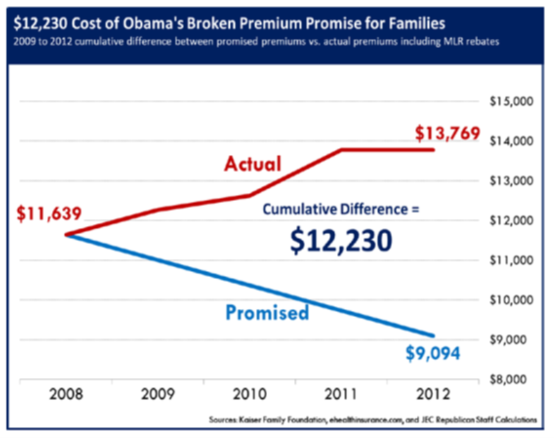
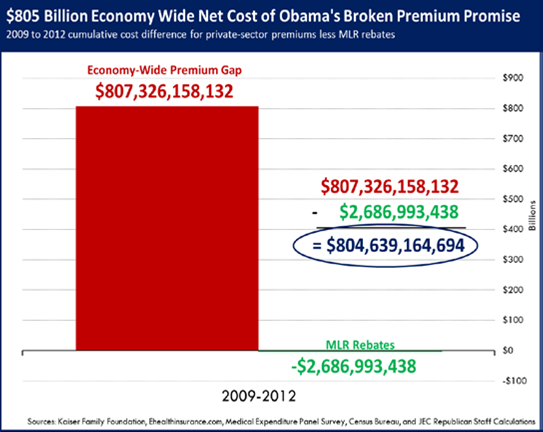
Of course, to be fair, the Medical Loss Ratio (MLR) provision of Obamacare will result in some health insurance enrollees receiving rebate checks from their insurance providers. This provision is Obamacare’s attempt at driving down insurance costs by dictating how insurance companies can spend money freely given to them by employers and individuals who wish to purchase their services. For the 2011 plan year, an estimated $1.3 billion in rebate checks will be sent to about 16 million enrollees, for an average rebate amount of $85.5 Assuming a similar level of rebates go out in 2013 for the 2012 plan year, the MLR rebates reduce the gap between promised premiums and actual premiums by less three-tenths of one percent, to a cumulative difference of $12,230 for the average family and $4,163 for the average individual. That is $12,230 less money that was spent (on something other than health insurance), saved, or invested by the average family and $4,163 less by the average individual.
When you add up all the extra money – beyond the level promised by candidate Obama – Americans have spent on health insurance over the past four years, the economy-wide impact is an astounding $805 billion.6 That’s as much as the President’s failed stimulus package, and not so far off from the initially reported $940 billion ten-year cost of Obamacare (the updated ten-year cost is $1.76 trillion, not including the costs of implementation).7 What’s worse though is that this figure will only rise over time as Obamacare’s many taxes and regulations continue to drive up the cost of health insurance.
In terms of full-time jobs, the $805 billion difference is equivalent to the cost of private-sector employers supporting an average of 3 million jobs each year between 2009 and 2012, and a total of 4.7 million jobs in 2012 alone.8
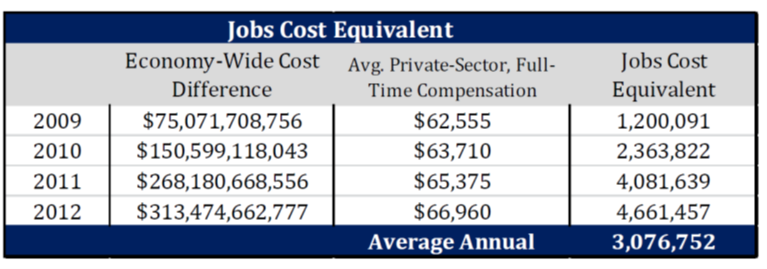
With more than $800 billion less in Americans’ pockets than Obama promised, it’s no wonder our economy continues to struggle. It is the government-knows-best view of the Obama Administration and Democrats in Congress that has contributed to the American economy stalling out. His promise to reduce premiums by $2,500 and his administration’s estimate that the stimulus would cut the unemployment rate to 5.7% (by July 2012) show President Obama’s conviction that government is the solution to driving down costs and creating jobs.9 Unfortunately, that conviction has proven unfounded. Excessive government spending and intervention have not driven down health insurance premiums by $2,500, but rather contributed to a $2,393 increase. And unprecedented deficit-financed stimulus spending has not brought the unemployment rate down to 5.7%, but rather kept it up at 8.2% with employers and investors holding back as Obamacare and other regulations have increased their costs and as unsustainable deficit spending has given rise to fear over coming tax hikes.
Analytical Appendix
Population and Insurance Coverage
The Census Bureau publishes data on the number of people in the United States with health insurance coverage. This data is broken down into private insurance coverage and government insurance coverage. Within private coverage, the data is segmented into individuals with employment based health insurance and direct purchase health insurance. The data from the Census Bureau goes through 2010. Data for 2011 and beyond is estimated based on the average annual percentage increase in each category of insurance from 1995-2010.
For allocation of insured individuals between individual or self-only plans and family plans, data was taken from the 2011 Medical Expenditure Panel Survey (MEPS). This data shows that individual or self-only plans made up 50.2% of all private sector employer health plans while family plans comprised the remaining 49.8%. This breakdown was also applied to the direct purchase market and across all years. The resulting allocation of individuals across private plan types is shown below.

For each family plan, there are assumed to be 3.05 members. This statistic is based on a breakdown of direct purchase family policies by size from ehealthinsurance.com, and it assumes an average of eight members per plan within the category of 6+ members.
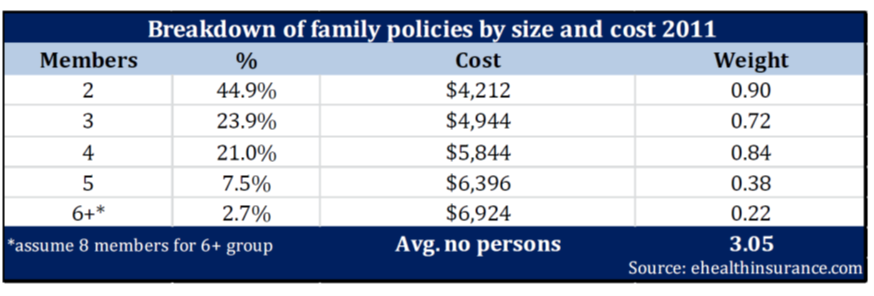
Premium Costs
Data on average annual premium costs for employment based health insurance come from the Kaiser Family Foundation Annual Employer Health Benefits Survey. Data on premium costs for direct purchase health insurance come from the ehealthinsurance.com Annual Cost and Benefit Reports. As of publication, the data from both of these sources was only available through 2011. The analysis conservatively assumes no rise in premiums from 2011 to 2012.

Promised Reductions
The promise of a $2,500 reduction in the average family premium by the end of President Obama’s first term is applied as a $625 per year reduction in costs for the average family premium (-$625 in 2009, -$1,250 in 2010, -$1,875 in 2011, and $-2,500 in 2012). The applicable promised reduction for the average individual or self only premium is $927 for employer based health insurance and $1,077 for direct purchase health insurance. These individual premium promised reduction amounts are based on the ratio of individual to family premium costs in 2008, when the promise was made. At that time, the average employment based individual premium was equal to 37.1% of the average family premium (.371*-$2,500 = -$927) while the average direct purchase individual premium was 43.1% of the average direct purchase family premium (.431*-$2,500 = -$1,077).

Aggregate Estimates of the Broken Promise
For aggregate estimates of amounts paid for health insurance vs. those promised, the number of people in each insured group (individual employment based, individual direct purchase, family employment based, and family direct purchase) was multiplied by the difference between the promised premium cost and the actual premium cost in each year from 2009 to 2012. The sum of additional premium costs across these privately-insured individuals and families from 2009 to 2012 amounts to $807 billion ($807,326,158,132). The new Medical Loss Ratio (MLR) component of the Affordable Care Act is estimated to result in roughly $1.3 billion ($1,343,496,719) in rebates to be paid by insurers to enrollees (beginning in August 2012) for the 2011 plan year. In keeping with the conservative estimate that premium costs did not rise from 2011 to 2012, MLR rebates in 2013 (for the 2012 plan year) are also assumed to hold steady at $1.3 billion. Excluding the $2.6 billion of cost-reducing MLR rebates, the total gap between promised and actual premium costs equals $805 billion ($804,639,164,694).

Jobs Equivalent Cost Estimates
Estimates translating the annual cost differences between promised and actual premiums into the cost of private-sector job creation were obtained by dividing the total economy-wide cost difference for each year by the average employee compensation for full-time, private-sector employees in that year. Compensation data comes from the Bureau of Labor Statistics Employer Costs for Employee Compensation Survey (data for 2012 was available only through the first quarter). The table below shows the annual jobs equivalent costs estimates.
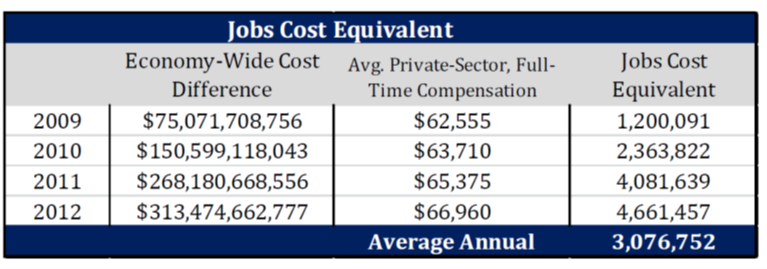
Endnotes
1 Freedom Eden, “Obama: 20 Promises for $2,500,” March 22, 2010, http://freedomeden.blogspot.com/2010/03/obama-20-promises-for-2500.html.
2 Kaiser Family Foundation, Annual Employer Health Benefits Surveys 2008-2011, http://www.kff.org/insurance/index.cfm.
3 Data on 2012 premiums costs for both employer based and direct purchase premiums were not yet available. This analysis relies on a conservative estimate that premiums will not rise in 2012, but will remain constant at their 2011 level.
4 Data on private, direct purchase health insurance premiums for 2008-2011 comes from ehealthinsurance.com. See Analytical Appendix for a detailed analysis of estimates.
5 Kaiser Family Foundation, “Insurer Rebates under the Medical Loss Ratio: 2012 Estimates,” April 2012, http://www.kff.org/healthreform/upload/8305.pdf
6 See Analytical Appendix.
7 Congressional Budget Office, “Estimate of direct spending and revenue effects for the amendment in the nature of a substitute released on March 18, 2010,” http://www.cbo.gov/sites/default/files/cbofiles/attachments/hr4872_0.pdf and “Updated Estimates for the Insurance Coverage Provisions of the Affordable Care Act,” March 13, 2012, http://cbo.gov/publication/43076.
8 Estimates based on data from the Bureau of Labor Statistics Employer Costs for Employee Compensation Survey (quarterly data through the 1st quarter of 2012) and private-sector, full-time employee compensation. In the 1st quarter of 2012, the average cost of employee compensation was $66,960.
9 Unemployment estimate comes from: Christina Romer and Jared Bernstein, “The Job Impact of the American Recovery and Reinvestment Plan,” January 9, 2009, http://www.politico.com/pdf/PPM116_obamadoc.pdf.